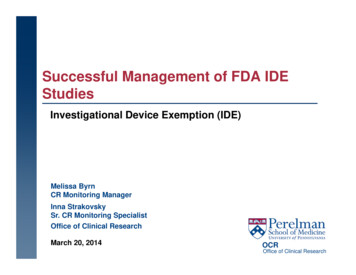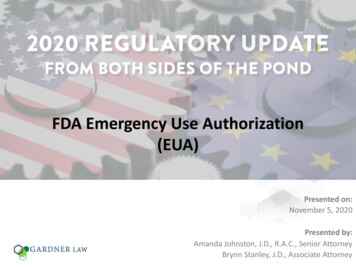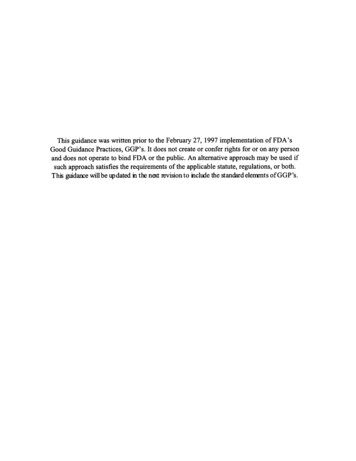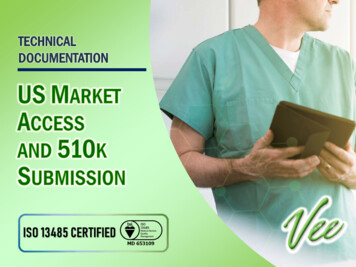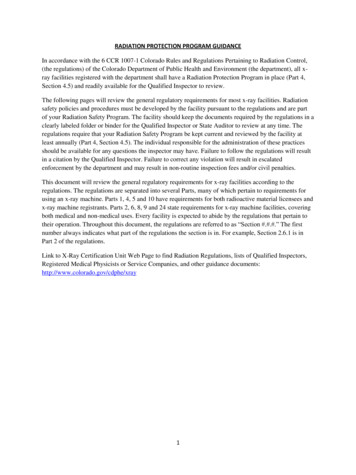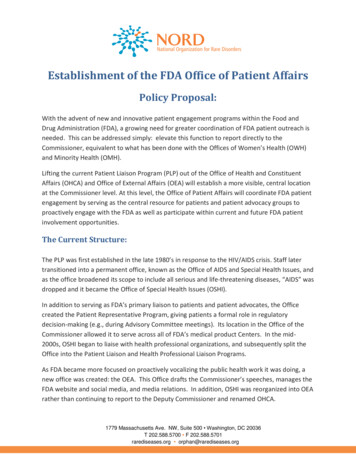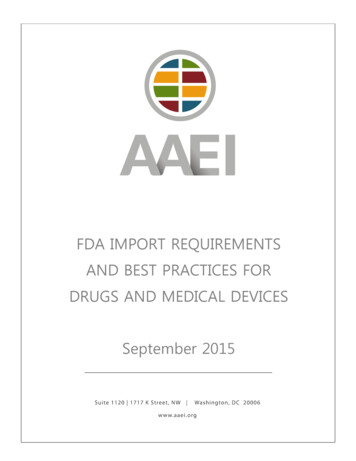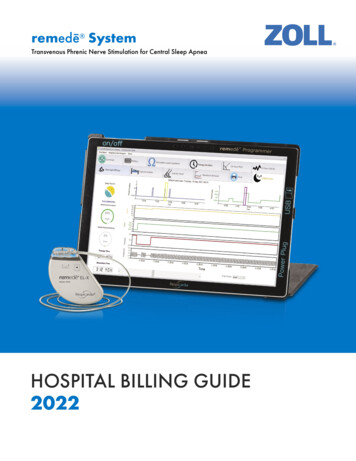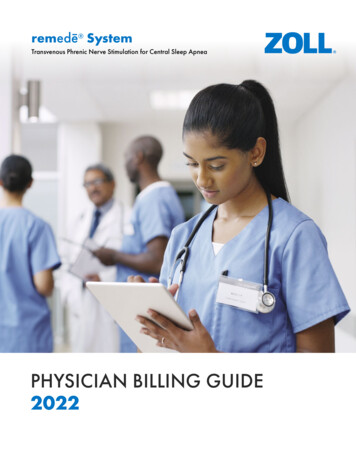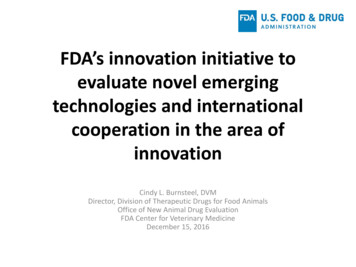
Transcription
FDA’s innovation initiative toevaluate novel emergingtechnologies and internationalcooperation in the area ofinnovationCindy L. Burnsteel, DVMDirector, Division of Therapeutic Drugs for Food AnimalsOffice of New Animal Drug EvaluationFDA Center for Veterinary MedicineDecember 15, 2016
Questions for Consideration What agency has jurisdiction? What are the evidentiary standards that mustbe met? How can you maximize the value of your earlywork to help meet the evidentiary standards? How can you fully utilize internationalinformation/obtain global approval?2
Jurisdiction in the U.S. EPA FIFRA USDA VSTA FDA/CVM FFDCAPesticidesAnimal DrugsBiologicsFood/FeedAdditives/GRAS FDA/CVM FFDCA3
Jurisdiction: FDA or EPA? Memorandum of Understanding Between TheEnvironmental Protection Agency and theUnited States Department of Health, Educationand Welfare, Food and Drug Administration SUBJECT: MOU with EPA regarding mutualresponsibilities under FFDCA and FIFRA.4
Pesticides that are drugsCertain pesticides subject to the laws administered by EPA are also deemed to be animaldrugs and subject to the laws administered by FDA under, but not necessarily limited to,the following conditions: i) Products for oral administration such as tablets, boluses, drinking waterpreparations, medicated blocks, and medicated feeds, including liquid feeds andsupplements (these do not apply to articles solely for the control of fecal breedingflies, nor solely for sanitizing the drinking water of animals). ii) Products administered parenterally. iii) Products which are absorbed through the skin surface as in demodectic mangeconditions. iv) Products introduced into wound or body openings, except for screwworms control,including application to the ear canal, for the control of ear mites; such conditionsoften require supportive treatment. v) Products applied topically for their systemic action in an animal.5
Jurisdiction: USDA or FDA? MOU between APHIS/USDA and FDA/HHS– procedures and responsibilities for resolving jurisdictionalissues/questions Determination is based on the primary mechanism of action,and the specific marketing claim made for the product Standing Committee – meet at least quarterly– Liaison from each agency Donna Malloy APHIS/Vitolis Vengris FDA Three (3) or more people from each agency– contact liaison for determination of jurisdiction– Decision will be communicated to applicant, in writing, by theagency with the regulatory authority6
Regulated as “drugs” 1. Antibiotics, including antimicrobial peptides such as alpha and betadefensins, chemotherapeutics 2. Anti-inflammatories (steroidal and nonsteroidal) 3. Anthelmintics/Antiprotozoals, except vaccines 4. Competitive Exclusion products 5. Genetic constructs, excluding DNA vaccines and live vaccines thatstimulate a protective immune response. 6. Stem cell therapies 7. Gene therapies and somatic cell therapies utilizing viral and nonviral vectors 8. Hormones, growth factors, growth promotants 9. Cytokines administered for systemic or anti-inflammatory effect7
Regulated as “drugs”, cont’d 10. Cytokines intended to treat mastitis either as (a) stand alonetherapies, (b) in combination with approved antibiotics or (c) any othertreatment modalities. 11. Cytokines of human origin for human use already regulated underthe FFDCA or the Public Health Service Act. 12. Cytokines that affect blood cell formation (hematopoiesis,erythropoiesis, myelopoiesis). 13. Interferons whose primary mechanism of action does not requirestimulation of the immune system. 14. Agents or products administered to animals for the purpose ofreducing human exposure to pathogens. 15. Whole blood, transfusion, and clotting products except serum andplasma products for passive transfer of immunity8
Regulated as biologics 1. Cytokines and/or interferons co-administered (a) with an approvedvaccine produced by the sponsor and intended to be an integralcomponent of the vaccine, (b) with an approved vaccine produced byanother supplier, or (c) with an approved vaccine produced by thesponsor but not intended to be used exclusively any one product. 2. Localized, including topically administered cytokines where the intentis to affect local immune responses and there is reasonable certainty thatadministration will not result in systemic circulation of the cytokine. 3. Cytokine nucleotide sequences administered, either as an integral partof a DNA vaccine, or administered as an adjunct to vaccineadministration.9
Regulated as biologics, cont’d 4. Bacteria, viruses, bacterial, and viral-derived products whose intendeduse is the treatment or cure of cancer in animals by immune mediatedmechanisms. 5. Bacterial-derived CpG oligonucleotides administered as a stand-alonetreatment. CpG oligonucleotides administered as part of a vaccine shallbe considered to be an integral part of the vaccine acting as an adjuvantand will be regulated by the Agency with jurisdiction over the vaccine. 6. Vaccines, viruses, bacterins, bacterial extracts, allergens, antiserums,antitoxins, toxoids, diagnostics, and immunomodulators for theprevention and/or treatment of animal disease. 7. Immunoglobulins, serum, and plasma for passive transfer.10
FDA Drug vs. Food Intended use of a substance determines if it is regulated as afood or a drug CVM Program Policy And Procedures Manual Guide1240.3605, Regulating Animal Foods With Drug Claims at /ucm046883.pdf Matrix listing to delineate drug vs. food11
Food Legal definition – Food is “articles used for food or drink for manor other animals” [21 USC 201(f)] Food is made of substances that Provide nutrition (nutritive value), taste, or aroma to theanimal Affect the characteristics of food12
Food Additive Defined in 21 USC 201(s) as “any substance the intended useof which results or may reasonably be expected to result,directly or indirectly, in its becoming a component of orotherwise affecting the characteristics of any food.” Section 201(s) excludes any substance that is GRAS or that qualifies forany of the other exemptions from the food additive definition (e.g., newanimal drug, color additive, etc.) Food additives require premarket approval Food additive petition process in 21 CFR 571.1 Guidance for Industry 221 – Recommendations for Preparationand Submission of Animal Food Additive Petitions m367746.pdf Approved animal food additives in 21 CFR 57313
Food Additives There are several types of food additives, based oncomposition and intended use, used for purposes such as:nutrient, aroma/flavor, taste, soluble or insoluble fiber,stabilization, emulsification, preservation, anti-oxidant, etc.A substance that does not become a component of the foodbut that is used, for example, in preparing an ingredient withinthe food to give it a different flavor, texture, or othercharacteristic may also be a food additive14
Food Additive Petition Food additive petition (21 CFR 570 and 571) shouldaddress:– Safety - to the animal and to humans consuming foodproducts from animals consuming the food additive– Utility - intended physical, nutritional or other technicaleffect– Manufacturing chemistry– Labeling - cautions, warnings, shelf life, directions foruse– CVM also evaluates the possibility for environmentalimpacts to occur15
Substance generally recognized as safe(GRAS) for intended use Generally recognized as safe (GRAS) (21 CFR 570.30) for aspecies-specific intended use– General recognition of that safety among qualified experts– Evidence of safety (based on history of safe use prior to 1958or scientific procedures) More information available at ons/default.html http://www.fda.gov/safefeed16
FDA - Animal Drugs Regulated under the Federal Food, Drug, and Cosmetic Act (FFDCA) Defined by intended use articles intended for use in the diagnosis, cure, mitigation, treatment, orprevention of disease in man or other animals articles (other than food) intended to affect the structure or any functionof the body of man or other animals17
ONADEs Vision/Mission Expeditiously approve quality safe and effective new animal drugproducts through a science-based approach in a regulatoryenvironment– Employ applicable science to make high quality safety and effectivenessdecisions– Keep unsafe and ineffective drugs off of the market Communicate with our stakeholders and understand the forces thataffect them– Understand the economics of the animal health industry as it pertains todrug availability Protect human, animal, and environmental health and promote a safeand abundant food supply18
How we measure success of ourpublic health missionPut in the hands of the end-user approved,safe and effective,quality manufactured,properly labelednew animal drugs to meet therapeuticand production need of animals19
Four Legal Pathways to Market An approved new animal drug application (NADA) under section512 of the FFDCA (Pioneer) An approved abbreviated NADA (ANADA) under section 512 of theFFDCA (Generic) A conditional approval under section 571 of the FFDCA or(MU/MS) An index listing under section 572 of the FFDCA (MU/MS)20
New Animal Drug Approval Process21
Four Critical Approval Standards Safety Human FoodTarget AnimalHuman UserEnvironmental Impact Effectiveness Quality Manufacturing Proper Labeling22
Technical Sections Effectiveness Target Animal Safety Human Food Safety Environmental Impact Manufacturing Chemistry Labeling All Other Information23
EffectivenessSubstantial Evidence One or more adequate and well- controlled studies Demonstrate the drug is effective for the intendeduse at the dose or dose range and associatedconditions of use prescribed, recommended orsuggested in the labeling24
Effectiveness studies, such asA laboratory dose confirmation studyA study in laboratory animalsAny field investigationA bioequivalence studySystematic review and meta-analysisAn in vitro study25
Target Animal SafetyAdequate tests by all methods reasonablyapplicable to show that the drug is safe foruse under the conditions prescribed,recommended or suggested in the proposedlabelingIncludes human user safety26
Target Animal Safety studies,such asPharmacologic/toxicologic studyMargin of Safety StudyTissue Irritation StudyReproductive safety studyA bioequivalence studyAnimal Class Safety Study (young, geriatric)Special Cases (specific breeds)27
Human Food Safety TOXICOLOGY:– determine the no observable effects level (NOEL), acceptable dailyintake (ADI), and safe concentration RESIDUE CHEMISTRY:– determine the target tissue, marker residue, slaughter withdrawal,and milk withhold times MICROBIAL FOOD SAFETY:– evaluate the safety of antimicrobials with regard to theirmicrobiological effects on bacteria of human health concern(Guidance 152 and 159) REGULATORY METHOD:– development and validation of methods to measure drug residues inedible tissues28
Human Food Safety studies, such asToxicologyGenotoxicity studies2 90-day studiesReproductive StudyDevelopmental study(ies)ResidueChemistryTotal residue metabolism andmetabolism in target animalsComparative metabolism in target andlaboratory speciesAnalytical methods development andvalidationUser safety informationTissue residue depletion studiesImpact on Human gut floraAdditional/Special studies (if needed)Method transfer trial29
Human Food SafetyMicrobialFood SafetyImpact of the use of antimicrobial newanimal drugs (and compounds withantibacterial activity) on the emergenceor selection of antimicrobial resistantbacteria in or on treated food-producinganimals and subsequently in or on food(GFI #152)RegulatoryMethoddevelopment and validation ofmethods to measure drug residues inedible tissues, including ademonstration of transferabilityImpact of the residues of antimicrobialor other NADs in food producinganimals on the intestinal flora of humanconsumers (GFI #159/VICH GL 36)30
Environmental ImpactNational EnvironmentalPolicy Act (NEPA)Requires FederalAgencies to considerenvironment impact oftheir actions31
Environmental ImpactCategorical Exclusion orEnvironmental introductionand fate studiesEnvironmental effects studiesEnvironmental assessment
Chemistry, Manufacturing, andControls sponsors demonstrate that the animal drug willhave and maintain the necessary quality,strength, purity, and identity Methods and controls Stability data cGMP compliance33
Chemistry,Manufacturing, andControlsDrug Substance CharacterizationExcipient ControlsMfg. Process ControlsSterile Process ValidationAnalytical ControlsPackaging ControlsStabilitycGMP Compliance
Labeling immediate container (vial, syringe, packet) orfeed bag labels package insert packaging (box, carton)35
All Other Information Drug sponsors must submit all information pertinent to anevaluation of the safety and effectiveness received or otherwise obtained by the applicant from anysource including information– derived from other investigations or commercial marketing(for example, outside the United States)– reports in the scientific literature, both favorable andunfavorable36
Genetically Engineered Animals Growing field Regulatory framework developed– GFI #187 published Three approvals Demonstrate that there are alternative ways toapprove drugs – alternative ways to meet theregulatory standard37
GE animal review process Hierarchical, weight-of-evidence, risk based– AND it Satisfies the statutory requirements forsafety and effectiveness– Follows NADA regulations with adaptations fortechnology/expertise38
Animal Drug Approval ProcessDiscovery MProof ofConceptApprovalInvestigationalNew Animal DrugFilePresubmissionconferenceAgree ondevelopment planSupportNew taLiteratureOther Information39
Need for New products/drugs What drives Discovery?– Predict the market 8-10 years out– Consumer demand/need Convenience/cost effective/effective– Current therapeutic vacuum– Resistance to approved products (antimicrobials)and need to discover alternatives40
Discovery Acquisition Partnerships Research Collaborations– Scientists– Academia– Veterinary colleges/universities41
Questions asked (andanswered) in Discovery Will the product meet an identified need? What is the claim? Does it possess desirable Effectiveness – Pharmacologic effects and in which species TAS – toxic endpoints HFS – based on the structure of the molecule/related compounds, is it safefor human food? dosage form Can it be manufactured at acceptable concentration and volume forconvenient administration at large/commercial scale Is it economical? Does it have market value? Are there market differentiators? Requires knowledge of current and future markets42
Proof of Concept Decision point between Discovery andDevelopment Management decision (business and scientific)whether or not to move molecule intoDevelopment– Does this fit into Co. portfolio/strategy Might be a great compound for pigs, but they aren’t in theswine market– Does it still have favorable projected marketplace– Is the available to pursue approval43
Early Development Many Small trials to identify any issues– Are there unacceptable TAS concerns? How does the drug behave in the target animal?– Pharmacology (absorption, distribution,metabolism, and excretion) Is there enough of an effect to pursuedevelopment?44
Full Development Sponsors are working toward meeting therequirements of the technical sections This is when sponsors typically open an INAD file(FDA) and begin communication with CVM– Pilot trials– Tox trials – HFS– Scale up to clinical batches Have a presubmission conference to agree on adevelopment plan.45
Discovery lINADINADopenedIdentify ProductIVETForm Tech TeamOpen VMFEarly InformationSupportNADANADAapproved scientific knowledge regulatory certainty Issue Identificationand Risk Analysis Transition to Review TeamSystematic process to identify knowledge needs,knowledge gaps, and regulatory strategy46
Shared Story of SuccessApprovalDevelopmentProof ofConcept
CVM Tools to Foster Development ofInnovative New Animal Drugs InnoVation Exploratory Team (IVET) Process Tech Teams Focus Groups IVET VMF files Early Information (EI)48
Early Information/Tech Teams Two processes exist to provide new avenues for earlier exchangeof information and dialogue between CVM and drug sponsors. The goal of the early information (EI) and tech team processes isto facilitate reaching agreement efficiently regarding some or allof the investigational requirements for approval at a PSC. These processes both may involve back and forth discussions orexchange of scientific information for mutual learning. These processes are best utilized for different purposes and mayhave different characteristics49
Early Information Available to all sponsors Focus is on a single proposed product CVM provides earlier answers to sponsor’s specificquestions, allowing the sponsor to propose adevelopment plan more acceptable to CVM Usually during the INAD process For alternatives to antibiotics, can happen prior toopening and INAD Example:Discussion on novel experimental designs50
Tech Team Sponsors can request; however, CVM determinesthe need CVM is able to learn along with the sponsor abouta new technology reduces the time CVM spends tolearn the technology after the INAD is opened. Exchange of information Team – that develop the expertise Example – Drugs using novel technologies51
Focus Groups internal teams used to address broad topicareas. may be technology-focused, such asbiomarkers, or process improvements. These might be formed based on conversationswith a sponsor.52
International Collaboration53
Utilize Opportunities forInternational Collaboration Veterinary Drug Directorate (VDD)– Regulatory Cooperation Council (RCC) – simultaneousreview VDD and FDA European Medicines Agency (EMA)– meet quarterly, scientist-to-scientist– Parallel Scientific advice available VICH – Chairs, EWGs Other opportunities for regulator-to-regulatorcollaboration (MOU/confidentiality agreementswith other countries)54
Simultaneous ApprovalsUnder RCC Currently there are 5 simultaneous approvalsImrestor (pegbovigrastim injection) the first simultaneously reviewed and approvedanimal drug for use in food-producing animalsNeed to submit the same information to FDA andVDD, meetings should involve both agencies55
Parallel Scientific Advice Allows for collaboration and harmonizationbetween US and other regions’ regulatoryagencies in the pre-approval stage Facilitates drug approvals by reducing divergentstudies for global registrations We have had 3 Parallel Scientific Advicemeetings with the EMA56
ADVENT Ad Hoc Expert Group on Veterinary NovelTherapies – EMA Similar to CVM’s IVET process Current EMA ADVENT groups :– Monoclonal antibodies for veterinary use: specific questionsto be addressed by ADVENT– Stem cell-based products for veterinary use: specificquestions on target animal safety to be addressed byADVENT57
Global Plan for a Global Approval Companies should share global plan for approval Leverage opportunities for us to work with our counterpartsin other countriesData sharing across regulatory bodies in different countries Single set of studies for approval in multiple counties Maximize the use of existing/foreign data Increasing the consistency of labeling across countries 58
Global Approvals — an achievable goal Sileo (dexmedetomidine oromucosal gel) Approval date EU — June 2015; US Nov. 2015 Indication– US — for the treatment of noise aversion in dogs– EU — for the alleviation of acute anxiety and fear associatedwith noise in dogs Substantial Evidence of Effectiveness– Field study 14 clinical investigators in Finland and Germany NO SITES IN THE U.S.59
Future for Drug approval forFood Animals We continue to have development of newchemical entities in food animals– 7 new chemical entities per decade since 1990 forfood animals We continue to approve new antibiotics andalternatives to antibiotics for food animals60
Summary There is a path to approval for your productMust meet the statutory requirementsStatutory requirements are set by CongressWe have processes to help guide youEncourage early communicationFirm is responsible for product developmentFDA ensures products meet the requirements61
7 Regulated as "drugs" 1. Antibiotics, including antimicrobial peptides such as alpha and beta-defensins, chemotherapeutics 2. Anti-inflammatories (steroidal and nonsteroidal)
